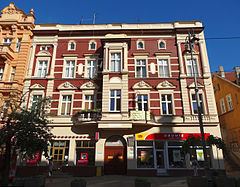Type Tenement Completed 1887 Floor count 3 Floors 3 Renovated 1909 | Country Poland Client Julius Grey Opened 1887 Architectural style Eclecticism Architect Rudolf Kern | |
 | ||
Location Gdańska street 35, Bydgoszcz, Poland Similar Theonia Reichhardt House in, Alexander Timm House, Emil Bernhardt tenement, August Mentzel Tenement | ||
The Julius Grey house is a house in downtown Bydgoszcz, at Gdanska Street 35.
Contents
Location
The building stands on the west side of Gdańska Street between Dworcowa and Śniadeckich streets.
Origins
The investor was Julius Grey, a baker, which ran there the bakery first and a confectionery factory in 1883. At this time, the address was Danzigerstrasse 23
Juilius Grey decided to have this place rebuilt and asked, in 1887, master builder Hermann Lewandowski, living at Louisenstrasse 13 (now Hetmanska street) to manage the project.
In 1909, the house has been rebuilt, designed by Rudolf Kern. The man had already realized several edifices renovation in Bydgoszcz:
- Tenement at Gdanska street 5 in the same year;
- Houses in Gdanska street (at 66, 67, 68 & 158);
- Tenement at August Cieszkowski street 10 in 1902-1903.
Pastry shop
During interwar period, the Grey family ran on the groung floor a pastry shop (Polish: Cukiernia), see advertisement picture in the gallery), which was famous for the quality of its cakes.
Upon basis of receipts issued in 1939 by the Germans, it is established that Stanislaw Hass, a master confectioner born in Grodzisk Mazowiecki in 1899, was running a café "Cristal" at Freedom Square 1.
Stanislaw came back to Bydgoszcz during winter of 1945, and managed to get post-war city authorities permission to restart the "Cristal". Having lost the place at Freedom Square 1, he moved to the former premises of the Grey family, at Gdanska 35, where part of the Grey's equipment and stocks were still available. Until 2003, the "Cristal" cafe with its typical Art Nouveau décor has been located here, even when the Hass family moved the pastry in the 1960s.
Architecture
The building was built in the style of Eclecticism using forms of German Historicism.
The edifice is remarkable by two symmetric rounded shape balconies with forged railings: they both enclose the large bay window standing above the entrance gate.
Window pediments are decorated with figure of a woman head.
